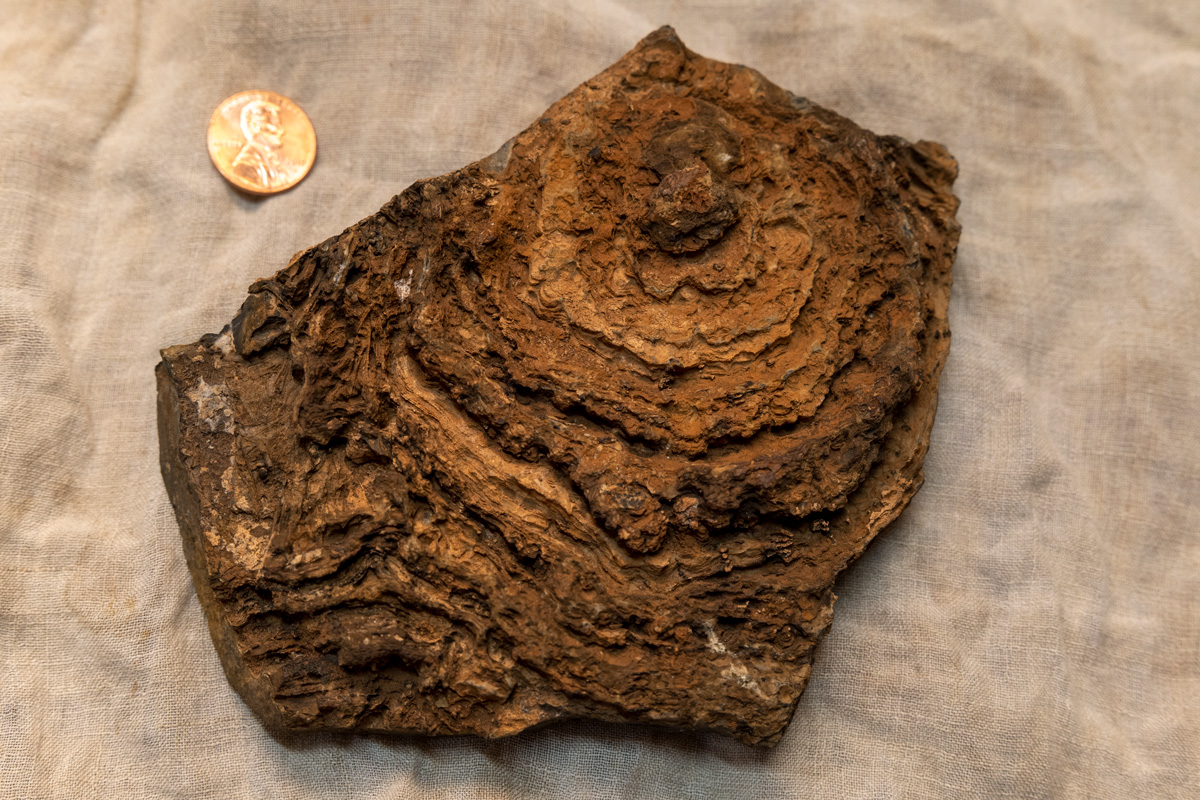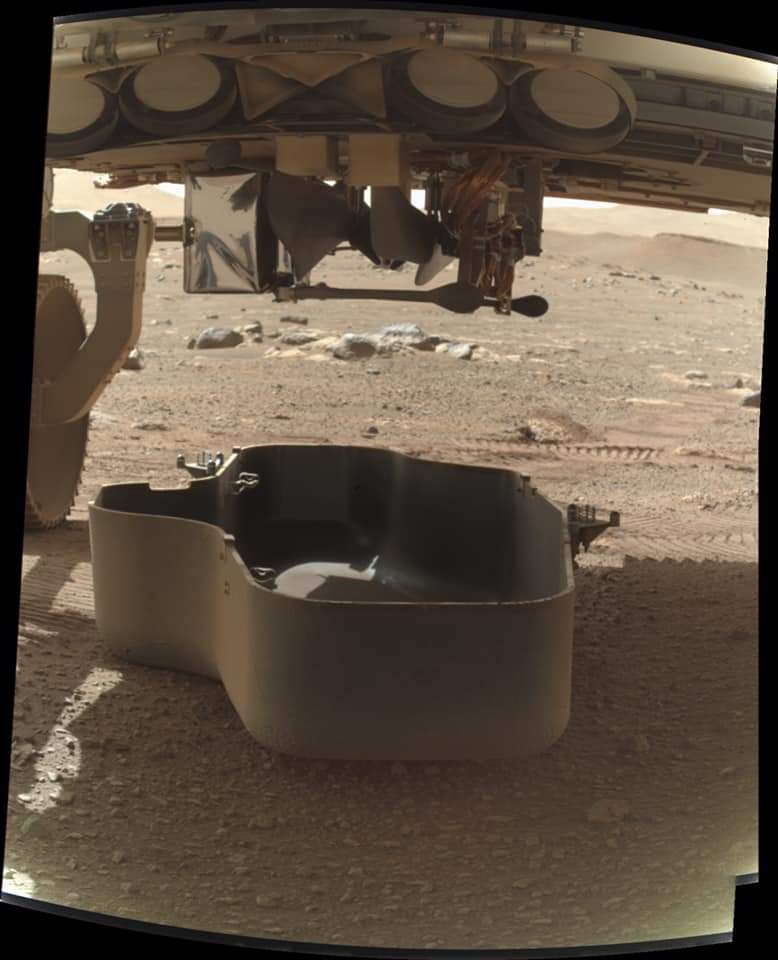It looks like you're using an Ad Blocker.
Please white-list or disable AboveTopSecret.com in your ad-blocking tool.
Thank you.
Some features of ATS will be disabled while you continue to use an ad-blocker.
share:
a reply to: panoz77
They're actually some distance apart, and too far from Perseverance to be seen.
www.nasa.gov...
It's most likely a lighting effect.
They're actually some distance apart, and too far from Perseverance to be seen.
www.nasa.gov...
It's most likely a lighting effect.
A sharp Mastcam-Z image will clear everything up pretty soon, I guess...
The first images of Mastcam-Z demonstrating its capabilities to zoom in on interesting features are now available in the RAW image archive. Among those we also find high-res imagery of the aforementioned feature often referred to as "shiny rock".
I made an animated GIF to show the first image (taken from more than 100 meters away) with a transition to the more detailed photo using Mastcam-Z's zoom camera:
Click for larger version...

What's amazing here is that the rover didn't change its position at all to acquire these better images. This goes to show how much Percy has improved compared to Curiosity and how quickly we can get high resolution images in order to identify features of interest.
I also created a panorama of the "shiny rock" scenery composed of three different images (of the newly uploaded Mastcam-Z zoom lens images):
Click for larger version...

Source: Image 1 | Image 2 | Image 3
edit on 28-2-2021 by jeep3r because: formatting
Just a brief update on what Percy will be up to regarding her upcoming astrobiology mission, the objective of which is to find biosignatures for
ancient life on Mars.
One of the things that the team is actually hoping to find are Stromatolites, which -upon first glance- look a bit like ordinary rocks:

From Earth we know that these Stromatolites were built up by living organisms whose activity results in Stromatolites having a rather distinct, layered appearance. The following excerpt explains their origin quite well:
There's also this article on the mission's website detailing what the hunt for ancient life on the red planet will look like and how this objective could be met. Of course, ultimate confirmation will require sample collection and analysis back on Earth.
However, I still think that maybe (just maybe) Percy will stumble upon something that's more or less undoubtedly indicative of fossilized organisms on Mars. Fingers crossed!
One of the things that the team is actually hoping to find are Stromatolites, which -upon first glance- look a bit like ordinary rocks:

From Earth we know that these Stromatolites were built up by living organisms whose activity results in Stromatolites having a rather distinct, layered appearance. The following excerpt explains their origin quite well:
Stromatolites | David L. Alles | Western Washington University
[Stromatolites are created] by algae and cyanobacteria (photosynthesizing bacteria). The microbes live in gooey mats on the top surface of the structures. The mats trap fine sediments carried across them by tidal currents. As the mats are made opaque by sediments, the microbes move upwards seeking sunlight. Layer after layer of sediments are cemented into growing columns or domes.
Source PDF
There's also this article on the mission's website detailing what the hunt for ancient life on the red planet will look like and how this objective could be met. Of course, ultimate confirmation will require sample collection and analysis back on Earth.
However, I still think that maybe (just maybe) Percy will stumble upon something that's more or less undoubtedly indicative of fossilized organisms on Mars. Fingers crossed!
a reply to: jeep3r
There a couple of new little gifs on the twitter page today with some good wheel twitching and robotic arm testing action:
twitter.com...
twitter.com...
All testing going well so far.
There a couple of new little gifs on the twitter page today with some good wheel twitching and robotic arm testing action:
twitter.com...
twitter.com...
All testing going well so far.
The resolution on these photos, and these gifs, is just amazing.
originally posted by: jeep3r
A sharp Mastcam-Z image will clear everything up pretty soon, I guess...
The first images of Mastcam-Z demonstrating its capabilities to zoom in on interesting features are now available in the RAW image archive. Among those we also find high-res imagery of the aforementioned feature often referred to as "shiny rock".
I made an animated GIF to show the first image (taken from more than 100 meters away) with a transition to the more detailed photo using Mastcam-Z's zoom camera:
Click for larger version...
What's amazing here is that the rover didn't change its position at all to acquire these better images. This goes to show how much Percy has improved compared to Curiosity and how quickly we can get high resolution images in order to identify features of interest.
I also created a panorama of the "shiny rock" scenery composed of three different images (of the newly uploaded Mastcam-Z zoom lens images):
Click for larger version...
Source: Image 1 | Image 2 | Image 3
Thanks so much for that gif, really shows the improved tech on Percy.
I wonder if we'll get to a point where there can be voting or image requests, like renting telescope time (digitally) to take astrophotography.
Photo released today of the helicopter. It's folded up and upside down. The debris shield was dropped, and now they plan to drive to the "helipad".


More sounds from Mars, recorded as Percy drives across the terrain.
www.nasa.gov...
Sounds like Mario is in the basement working on the plumbing.
Meanwhile, Ingenuity is sittin' pretty, set to start a slew of pre flight tests tomorrow ( including releasing the rotor tie-downs ), before hopefully lifting off later this month.
www.nasa.gov...
(beware this last link also has a 3-D model on the page, which makes for a longer than usual load time)
www.nasa.gov...
Sounds like Mario is in the basement working on the plumbing.
Meanwhile, Ingenuity is sittin' pretty, set to start a slew of pre flight tests tomorrow ( including releasing the rotor tie-downs ), before hopefully lifting off later this month.
If all goes well with each of the myriad preflight checks, Ingenuity’s first attempt to lift off from the middle of its 33-by-33-foot (10-by-10-meter) “airfield” – chosen for its flatness and lack of obstructions – will be no sooner than the evening of April 11.
www.nasa.gov...
(beware this last link also has a 3-D model on the page, which makes for a longer than usual load time)
edit on Tue Apr 6 2021 by Jbird because: (no reason given)
I appreciate the effort and the technical expertise it takes to shoot a rocket all the way to Mars and get a probe to land there. Insanely
difficult.
However, I don't think they'll find what they're looking for there. The thing about life is that if you give it just a tiny chance to survive and grow, it'll do it. You can drop a probe practically anywhere on Earth and you'll find life there in 15 minutes or less. It's everywhere. So the idea that you have to dig to find it or traces of it or be in just the right spot doesn't really work for me.
But good luck, though. I'm no exobiologist. It would be cool if they found something for sure and not just "inconclusive."
However, I don't think they'll find what they're looking for there. The thing about life is that if you give it just a tiny chance to survive and grow, it'll do it. You can drop a probe practically anywhere on Earth and you'll find life there in 15 minutes or less. It's everywhere. So the idea that you have to dig to find it or traces of it or be in just the right spot doesn't really work for me.
But good luck, though. I'm no exobiologist. It would be cool if they found something for sure and not just "inconclusive."
new topics
-
A call to repentance—God is patient, but His patience does not abide forever.
Religion, Faith, And Theology: 7 hours ago -
My Pet Elephant For A Day…
Short Stories: 7 hours ago -
Congress 2024 - We do not want me in our ladies rooms
US Political Madness: 7 hours ago
top topics
-
A Question for You on the Left
Political Ideology: 14 hours ago, 18 flags -
Dr Cambell talking about using worm meds for cancer
Medical Issues & Conspiracies: 13 hours ago, 14 flags -
Looks like Biden kicked off WWIII and Putin threatening nukes to retaliate
World War Three: 15 hours ago, 9 flags -
Congress 2024 - We do not want me in our ladies rooms
US Political Madness: 7 hours ago, 8 flags -
My Pet Elephant For A Day…
Short Stories: 7 hours ago, 6 flags -
Words of Wisdom from the Dear Leader - Transcribed for the World
Regional Politics: 15 hours ago, 4 flags -
A call to repentance—God is patient, but His patience does not abide forever.
Religion, Faith, And Theology: 7 hours ago, 2 flags
active topics
-
-@TH3WH17ERABB17- -Q- ---TIME TO SHOW THE WORLD--- -Part- --44--
Dissecting Disinformation • 3315 • : 777Vader -
Well, here we go red lines crossed Biden gives the go ahead to use long range missiles
World War Three • 241 • : yuppa -
DefCon Teetering on Escalation
World War Three • 43 • : NorthOS -
A Question for You on the Left
Political Ideology • 40 • : atsalex2 -
Congress 2024 - We do not want me in our ladies rooms
US Political Madness • 4 • : matafuchs -
President-Elect DONALD TRUMP's 2nd-Term Administration Takes Shape.
Political Ideology • 224 • : WeMustCare -
Incoming TRUMP Admin will Declare a National Emergency to Mass Deport People Here Illegally.
Social Issues and Civil Unrest • 113 • : WeMustCare -
Former DOJ charged with defrauding Rep. Matt Gaetz’s family over sex-crimes investigation
Propaganda Mill • 38 • : WeMustCare -
President-elect TRUMP Picks MATT GAETZ for his ATTORNEY GENERAL - High Level PANIC Ensues.
2024 Elections • 104 • : WeMustCare -
WATCH LIVE: US Congress hearing on UFOs, unidentified anomalous phenomena
Aliens and UFOs • 137 • : WeMustCare

